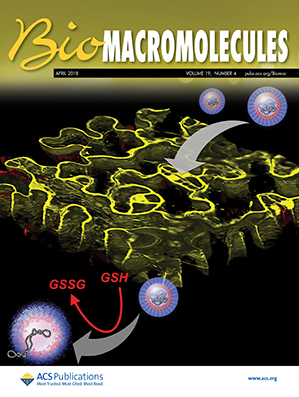Highlighting the Influence between Physical and Chemical Cross-Linking in Dynamic Hydrogels for Two-Photon Micropatterning
IF 5.4
2区 化学
Q1 BIOCHEMISTRY & MOLECULAR BIOLOGY
引用次数: 0
Abstract
Photolabile hydrogels have gained tremendous interest for a wide range of applications in materials and life sciences. Usually, photodegradability is introduced via chromophores and labile bonds, making such materials intrinsically light sensitive. In recent years, disulfide bonds have emerged as an innovative alternative, as they can be selectively cleaved in the presence of (photo)generated radicals. However, such materials suffer from limited network stability and high swelling as a result of thiol–disulfide metathesis reactions. Herein, we present two strategies to counteract such phenomena by network stabilization either via physical or chemical incorporation of (un)modified gelatin macromers to norbornene-modified poly(vinyl alcohol) networks. Photolabile behavior was introduced by a simple disulfide-containing dithiol cross-linker. Tunable material properties were investigated by means of in situ photorheology, in vitro swelling, and degradation experiments. Finally, we demonstrate an innovative method for localized disulfide cleavage via two-photon micropatterning.
- Download: Download high-res image (100KB)
- Download: Download full-size image
强调动态水凝胶中物理和化学交联对双光子微图的影响。
光性水凝胶在材料科学和生命科学中有着广泛的应用。通常,光降解性是通过发色团和不稳定键引入的,这使得这种材料本质上是光敏的。近年来,二硫键作为一种创新的替代品出现,因为它们可以在生成的自由基存在下选择性地断裂。然而,这种材料的网络稳定性有限,并且由于硫醇-二硫化物的复分解反应而存在高度膨胀。在这里,我们提出了两种策略,通过物理或化学结合(未)改性明胶大分子到降冰片烯改性聚乙烯醇网络来抵消这种现象。通过一种简单的含二硫化物的二硫醇交联剂引入了光致不稳定性。通过原位光流变学、体外溶胀和降解实验研究了可调材料的性能。最后,我们展示了一种创新的方法,通过双光子微图进行局部二硫解理。
本文章由计算机程序翻译,如有差异,请以英文原文为准。
求助全文
约1分钟内获得全文
求助全文
来源期刊

Biomacromolecules
化学-高分子科学
CiteScore
10.60
自引率
4.80%
发文量
417
审稿时长
1.6 months
期刊介绍:
Biomacromolecules is a leading forum for the dissemination of cutting-edge research at the interface of polymer science and biology. Submissions to Biomacromolecules should contain strong elements of innovation in terms of macromolecular design, synthesis and characterization, or in the application of polymer materials to biology and medicine.
Topics covered by Biomacromolecules include, but are not exclusively limited to: sustainable polymers, polymers based on natural and renewable resources, degradable polymers, polymer conjugates, polymeric drugs, polymers in biocatalysis, biomacromolecular assembly, biomimetic polymers, polymer-biomineral hybrids, biomimetic-polymer processing, polymer recycling, bioactive polymer surfaces, original polymer design for biomedical applications such as immunotherapy, drug delivery, gene delivery, antimicrobial applications, diagnostic imaging and biosensing, polymers in tissue engineering and regenerative medicine, polymeric scaffolds and hydrogels for cell culture and delivery.
 求助内容:
求助内容: 应助结果提醒方式:
应助结果提醒方式:


